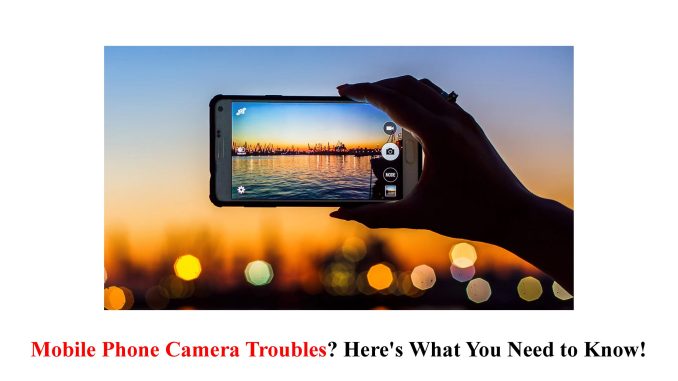
Are you tired of blurry selfies and grainy photos? Are your mobile phone camera troubles ruining those picture-perfect moments? Don’t worry, because help is here! In this blog post, we’ll dive into the common issues that plague mobile phone cameras and provide you with valuable tips and solutions to overcome them. Whether it’s troubleshooting camera problems, upgrading your camera setup, or taking better photos on your phone, we’ve got you covered. So grab your mobile device and get ready to capture stunning shots like a pro!
Common Issues with Mobile Phone Cameras
Blurry photos, washed-out colors, and poor low-light performance – these are just a few of the common issues that mobile phone camera users often encounter. One major culprit is shaky hands. Even the slightest movement can result in blurry images, especially when using the rear camera or shooting in low light conditions. To combat this problem, try bracing your arms against a stable surface or invest in a tripod for more professional results.
Another frequent annoyance is insufficient storage space. Many people have experienced that dreaded “Storage Full” notification right when they’re about to capture an important moment. To avoid missing out on precious memories, regularly back up your photos and videos to cloud-based services like Google Photos or iCloud.
Overexposure is another issue that can plague mobile phone cameras. When taking pictures outdoors with bright sunlight or shooting subjects against strong backlighting, it’s common for some areas of the photo to be overly exposed while others remain dark. To overcome this challenge, tap on the brighter area of your screen before taking the shot to adjust exposure levels manually.
Noise and graininess can detract from the overall quality of your photos—especially noticeable in low-light situations. While smartphones continue to improve their low-light capabilities, it’s still essential to find well-lit environments whenever possible or utilize additional lighting sources like lamps or external LED lights for better results.
With these common problems identified and solutions at hand, you’ll be well-prepared to tackle any challenges that may arise when capturing those picture-perfect moments with your mobile phone camera! So let’s dive into troubleshooting techniques next!
How to Troubleshoot Camera Problems
Is your mobile phone camera acting up and giving you trouble? Don’t worry, we’ve got you covered! Camera issues can be frustrating, but there are some simple troubleshooting steps you can take to try and fix them.
Check if the problem is with the hardware or software. If it’s a software issue, try restarting your phone or updating the camera app. Sometimes a simple reboot can solve minor glitches. If that doesn’t work, clear the cache of your camera app or reinstall it to ensure all settings are reset.
If the problem persists, it might be a hardware issue. Check if there is any dirt or smudges on the lens that could be affecting image quality. Gently clean it with a microfiber cloth. Also, make sure there are no physical damages like cracks or scratches on the lens.
Another common issue is blurry photos. This could be due to shaky hands while taking pictures. To overcome this problem, use both hands to hold your phone steady or consider using a tripod for more stability.
Sometimes lighting conditions can affect photo quality as well. Experiment with different lighting settings such as HDR (High Dynamic Range) mode in bright daylight or Night Mode in low light situations.
If none of these troubleshooting steps resolve the issue and you rely heavily on photography with your mobile phone camera for work or personal purposes, it might be time to consider upgrading to a new device with better camera capabilities.
Remember that every smartphone has its own set of troubleshooting methods specific to their brand and model number so don’t forget to consult their user manual for additional guidance tailored specifically for your device!
Stay tuned for our next blog section where we discuss whether upgrading your camera is worth considering and delve into tips for taking better photos on your mobile phone!
Upgrading Your Camera: The Pros and Cons
When it comes to mobile phone cameras, there often comes a time when you start considering an upgrade. Is it worth it? Let’s weigh the pros and cons.
One of the biggest advantages of upgrading your camera is improved image quality. Newer smartphone models come equipped with advanced sensors and lenses that capture more detail, vibrant colors, and better low-light performance. Say goodbye to blurry shots or grainy images!
Another benefit is the addition of new features and technologies. Upgraded cameras often offer enhanced zoom capabilities, portrait modes for stunning depth-of-field effects, and even night mode options for capturing breathtaking nighttime scenes.
However, there are also some drawbacks to consider before diving into an upgrade frenzy. Cost can be a significant factor as newer models tend to come with a higher price tag. Additionally, learning how to navigate through new camera settings might take some time and practice.
Keep in mind that constantly upgrading your camera may not always guarantee significantly better results if you don’t have a good understanding of photography basics such as composition or lighting techniques.
Deciding whether or not to upgrade your mobile phone camera depends on your personal needs and budget constraints. Assessing what features matter most to you as a photographer will help make an informed decision about investing in a new device.
Remember though; even with the latest technology at your fingertips, taking great photos still requires skillful framing and creative vision! So while upgrading can certainly enhance your photographic experience, never underestimate the power of honing your own abilities behind the lens!
Tips for Taking Better Photos on Your Phone
Nowadays, almost everyone has a mobile phone with a camera. It’s become our go-to device for capturing special moments and documenting our lives. However, taking great photos on your phone isn’t always as easy as it seems. To help you up your photography game, here are some practical tips to improve the quality of your mobile phone photos.
Lighting is key when it comes to photography. Natural light is generally the best option, so try to take advantage of outdoor settings or well-lit areas indoors. Avoid using flash whenever possible, as it can often result in harsh and unnatural-looking images.
Composition plays a crucial role in creating visually appealing photos. Consider the rule of thirds – imagine breaking an image into nine equal parts by drawing two vertical lines and two horizontal lines across it. Place important elements along these lines or at their intersections to create more balanced and interesting shots.
Don’t be afraid to get close! Mobile phone cameras have improved greatly over the years, allowing us to capture incredible detail up close. Experiment with different angles and perspectives to add visual interest and depth to your photographs.
In addition, don’t forget about editing apps! There are countless options available that can enhance your photos further by adjusting brightness, contrast, saturation levels, cropping images, adding filters or effects – all right at your fingertips.
Lastly but certainly not least – practice makes perfect! Take every opportunity you can to snap pictures with your mobile phone camera. The more you practice framing shots and experimenting with different settings/features on your device’s camera app; the better understanding you’ll develop regarding what works best for various scenarios!
So next time you reach for your mobile phone camera; keep these tips in mind: focus on lighting & composition techniques; utilize editing apps if needed; practice regularly – soon enough you’ll notice significant improvement in the quality of your mobile photography skills!
Utilizing Editing Apps for Professional-Looking Photos
In today’s digital age, capturing the perfect photo is just the first step. To truly make your mobile phone camera shots stand out, you need to take advantage of editing apps that can enhance and transform your images into professional-looking masterpieces. These apps offer a wide range of tools and features that allow you to adjust brightness, contrast, saturation, and more.
One popular app is Adobe Lightroom Mobile which offers powerful editing capabilities right at your fingertips. With its intuitive interface, you can easily make adjustments to exposure levels or apply creative filters to add depth and vibrancy to your photos.
Another great option is Snapseed, developed by Google. This app provides a comprehensive set of editing tools including selective adjustment brushes and healing tools for removing unwanted objects from your images.
VSCO is also worth mentioning as it not only has advanced editing features but also offers a wide selection of stylish filters inspired by film photography. It allows you to create unique looks that match your personal style or the mood you want to convey in your photos.
The key with using these editing apps is finding the right balance between enhancing an image without overdoing it. Remember that less is often more when it comes to professional-looking edits.
By utilizing these editing apps effectively, you can turn ordinary snapshots into extraordinary works of art that will impress friends and followers alike on social media platforms like Instagram or Facebook.
So don’t be afraid to experiment with different settings and effects within these apps – let your creativity soar! With some practice and patience, you’ll soon be producing stunning photos that rival those taken with expensive DSLR cameras.
Important Factors to Consider When Choosing a New Phone for Photography
When it comes to choosing a new phone for photography, there are several important factors that you should consider. First and foremost, the camera specifications of the phone should be your top priority. Look for a phone with a high-resolution camera and optical image stabilization (OIS) technology. This will ensure that your photos turn out sharp and clear, even in low light conditions.
Another crucial factor to consider is the availability of manual controls. Some phones offer advanced features such as manual focus, white balance adjustment, and exposure control. These options allow you to have more control over your shots and unleash your creativity as a photographer.
In addition to camera specifications, pay attention to the software capabilities of the phone. Look for phones that offer robust editing tools built into their native camera apps or ones that support third-party editing apps seamlessly. This will enable you to enhance your photos right on your device without needing additional software.
Battery life is also an important consideration when choosing a phone for photography. You don’t want to run out of battery while capturing those perfect moments. Look for phones with long-lasting batteries or ones that support fast charging so you can quickly get back in action.
Consider storage capacity and expandability options. Photography generates large files, so having ample storage space is essential if you plan on taking many photos or shooting videos frequently.
By considering these factors carefully before making your purchase decision, you can ensure that you choose a phone that meets all your photography needs and allows you to take stunning pictures wherever you go!
Conclusion
Mobile phone cameras have become an integral part of our lives. They allow us to capture precious moments, express our creativity, and share our experiences with others. However, like any technology, they can sometimes encounter issues.
If you’re experiencing troubles with your mobile phone camera, don’t panic! Start by troubleshooting the common problems mentioned earlier in this article. Often, a simple reset or adjustment can resolve minor issues.
If you find that your camera problems persist or if you’re looking for better quality and features, consider upgrading your device. The decision to upgrade should be based on careful consideration of the pros and cons discussed in this article. Remember to prioritize factors such as image quality, resolution capabilities, lens options, and low-light performance when choosing a new phone for photography.
Once you have a reliable camera at hand, practice taking better photos by following the tips shared in this article. Use natural lighting whenever possible and experiment with angles and composition to add interest to your shots. Additionally



Leave a Reply